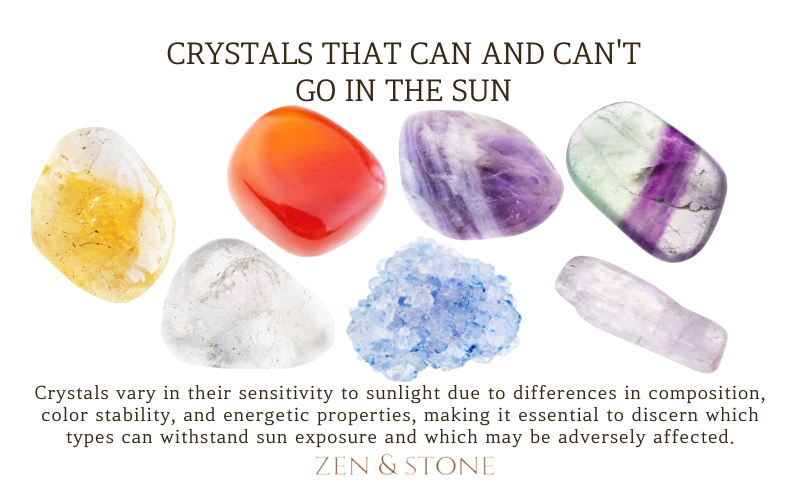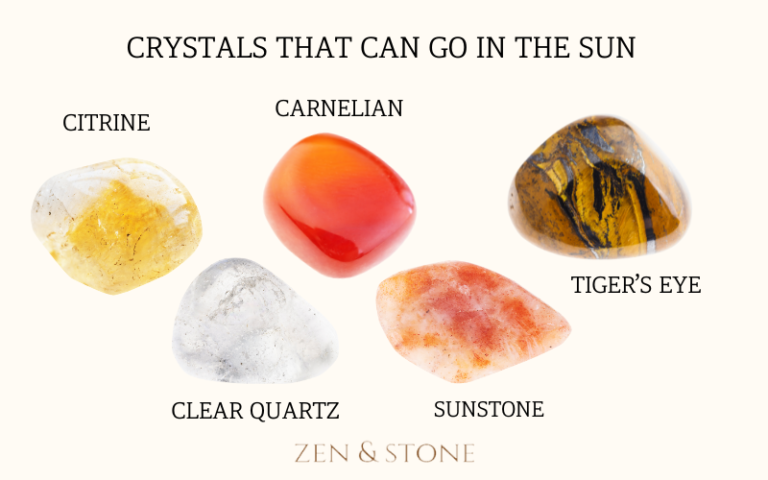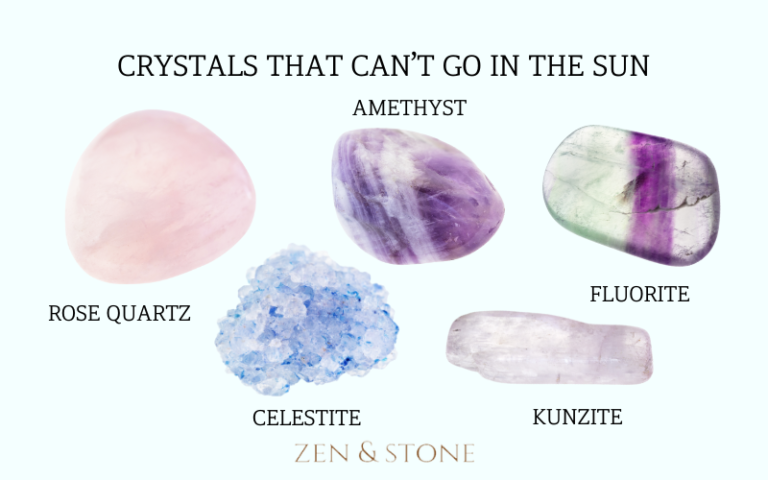
15 Nov Crystals That Can and Can’t Go In The Sun
Crystals are believed to have healing properties and are often used in various forms of alternative medicine. However, not all crystals react well to sunlight. Some crystals can get damaged or fade in color when exposed to sunlight for a prolonged period. It is essential to know which crystals can and can’t go in the sun to avoid any damage or loss of their properties.
This article provides a complete list of crystals that can and can’t go in the sun. It includes information on how sunlight affects different types of crystals and what precautions one should take to protect them. Whether you are a crystal enthusiast or just starting to explore their benefits, this article will help you make informed decisions about how to care for your crystals and keep them in their best condition.
Understanding Sunlight and Crystals
Sunlight is an important factor to consider when working with crystals. Some crystals can be damaged or fade when exposed to direct sunlight, while others thrive in the sun.
The main reason for this is that sunlight contains UV rays that can affect the color and structure of certain crystals. UV rays can cause some crystals to fade or even crack over time.
It’s important to note that not all crystals are affected by sunlight in the same way. Some crystals, such as Amethyst and Citrine, are known to fade when exposed to sunlight for prolonged periods. On the other hand, crystals like Clear Quartz and Rose Quartz can be safely exposed to sunlight without any negative effects.
It’s also important to consider the color of the crystal when deciding whether or not it can be exposed to sunlight. Darker crystals, such as Black Tourmaline and Obsidian, are less likely to be affected by sunlight than lighter colored crystals like Amethyst and Rose Quartz.
Crystals That Can Go In The Sun
When it comes to crystals, not all of them are suitable for exposure to sunlight. However, some crystals are known to thrive in the sun, absorbing its energy and amplifying their healing properties. Here are some crystals that can go in the sun:
Quartz Crystals
Quartz crystals are one of the most versatile and popular stones in the mineral kingdom. They are known for their ability to amplify energy and are often used in healing and meditation practices. Quartz crystals can be safely placed in the sun without any adverse effects.
Sunstone
Sunstone is a bright and sunny crystal that is believed to bring joy and happiness into one’s life. It is also known to enhance creativity and promote self-confidence. Sunstone can be placed in the sun without any adverse effects.
Citrine
Citrine is a beautiful, golden-yellow crystal that is often associated with abundance and prosperity. It is known to enhance creativity and promote self-confidence. Citrine can be safely placed in the sun without any adverse effects.
Tiger’s Eye
Tiger’s Eye is a powerful stone that is believed to bring courage, strength, and protection. It is also known to enhance creativity and promote self-confidence. Tiger’s Eye can be safely placed in the sun without any adverse effects.
Crystals That Can't Go In The Sun

Some crystals are sensitive to sunlight and can fade or get damaged if exposed to direct sunlight for extended periods. Here are some crystals that should be kept away from the sun:
Amethyst
Amethyst is a beautiful purple crystal that is known for its calming and soothing properties. However, it is also sensitive to sunlight and can fade over time if exposed to direct sunlight. To keep your amethyst looking beautiful, it’s best to keep it out of the sun.
Rose Quartz
Rose quartz is a lovely pink crystal that is often used for love and healing. However, it is also sensitive to sunlight and can fade over time if exposed to direct sunlight. To keep your rose quartz looking its best, it’s best to keep it out of the sun.
Celestite
Celestite is a stunning blue crystal that is believed to have calming and uplifting properties. However, it is also sensitive to sunlight and can fade over time if exposed to direct sunlight. To keep your celestite looking its best, it’s best to keep it out of the sun.
Kunzite
Kunzite, like many gemstones, is sensitive to prolonged exposure to sunlight. The color of kunzite can fade or change when exposed to ultraviolet (UV) light, which is present in sunlight. This phenomenon is known as “fading” or “color change.”
Fluorite
Fluorite is another gemstone that can be sensitive to prolonged exposure to sunlight. It is known for its wide range of colors, including greens, purples, blues, and yellows. Similar to kunzite, certain colors of fluorite may experience fading or changes when exposed to ultraviolet (UV) light, which is present in sunlight.
It’s important to note that these are not the only crystals that are sensitive to sunlight. If you have any doubts about whether a crystal should be kept out of the sun, it’s best to err on the side of caution and keep it in a shaded area.

Factors Determining Sunlight Tolerance
When it comes to determining whether a crystal can or can’t go in the sun, there are several factors to consider. These factors include:
- Color: The color of a crystal can play a role in its sunlight tolerance. Generally, darker colored crystals are more tolerant of sunlight, while lighter colored crystals may be more sensitive to it.
- Structure: The structure of a crystal can also impact its ability to withstand sunlight. Crystals with a more compact structure are typically more resistant to sunlight than those with a looser structure.
- Chemical Composition: The chemical composition of a crystal can also determine its sunlight tolerance. Some crystals may contain minerals that are more susceptible to damage from sunlight.
- Heat Resistance: Another factor to consider is the crystal’s heat resistance. Some crystals may be able to withstand direct sunlight, but only if the temperature is not too high.
- Location: The location where the crystal is being used can also impact its sunlight tolerance. For example, a crystal that is used outdoors in a hot, sunny climate may be more susceptible to damage from sunlight than one that is used indoors in a cooler environment.
Caring for Sun-Sensitive Crystals
Some crystals are sensitive to sunlight and can fade or become damaged when exposed to direct sunlight for extended periods. It’s important to know which crystals are sun-sensitive and how to care for them to prevent damage.
Here are some tips for caring for sun-sensitive crystals:
- Store them in a cool, dark place: When not in use, store sun-sensitive crystals in a cool, dark place to prevent exposure to sunlight. This can be a drawer, a box, or a cabinet.
- Avoid wearing them in direct sunlight: If you’re wearing sun-sensitive crystals, avoid direct sunlight. If you’re going to be outside for an extended period, consider leaving your crystals at home or keeping them in a bag or pouch.
- Use a UV-resistant display case: If you want to display your sun-sensitive crystals, consider using a UV-resistant display case. This will protect your crystals from direct sunlight while still allowing them to be seen.
- Rotate your crystals: If you have a collection of sun-sensitive crystals, rotate them regularly to ensure that they all get a chance to be displayed without being exposed to direct sunlight for extended periods.
- Clean them gently: When cleaning sun-sensitive crystals, use a gentle method that won’t damage them. Avoid using harsh chemicals or abrasive materials.
By following these tips, you can help ensure that your sun-sensitive crystals stay in good condition and retain their beauty for years to come.
Misconceptions and Myths
There are many misconceptions and myths surrounding the use of crystals in the sun. One common myth is that all crystals can withstand direct sunlight. This is not true, as some crystals are more sensitive to light and heat than others.
Another misconception is that leaving crystals in the sun will automatically charge them with energy. While sunlight can be a powerful source of energy, it is not the only way to charge crystals. In fact, some crystals may actually lose their energy or become damaged if left in direct sunlight for too long.
It is also important to note that not all crystals are safe to use in the sun. Some crystals may fade or change color when exposed to sunlight, while others may even crack or break. It is important to research each crystal before exposing it to sunlight to ensure that it is safe and will not be damaged.
Conclusion
In conclusion, it is important to consider the properties of each crystal before exposing them to sunlight. Some crystals can withstand the sun’s energy and even benefit from it, while others can become damaged or faded.
When using crystals for healing or spiritual purposes, it is recommended to research their properties and care instructions to ensure they are being used safely and effectively. It is also important to remember that crystals should not be used as a substitute for medical treatment.
Overall, the list provided in this article can serve as a helpful guide for determining which crystals can and cannot go in the sun. However, it is always best to consult with a knowledgeable practitioner or do further research before using any crystal in a specific way.
Sorry, the comment form is closed at this time.